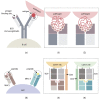Peptide-Based Vaccines: Foot-and-Mouth Disease Virus, a Paradigm in Animal Health
- PMID: 34066901
- PMCID: PMC8150788
- DOI: 10.3390/vaccines9050477
Peptide-Based Vaccines: Foot-and-Mouth Disease Virus, a Paradigm in Animal Health
Abstract
Vaccines are considered one of the greatest global health achievements, improving the welfare of society by saving lives and substantially reducing the burden of infectious diseases. However, few vaccines are fully effective, for reasons ranging from intrinsic limitations to more contingent shortcomings related, e.g., to cold chain transport, handling and storage. In this context, subunit vaccines where the essential antigenic traits (but not the entire pathogen) are presented in rationally designed fashion have emerged as an attractive alternative to conventional ones. In particular, this includes the option of fully synthetic peptide vaccines able to mimic well-defined B- and T-cell epitopes from the infectious agent and to induce protection against it. Although, in general, linear peptides have been associated to low immunogenicity and partial protection, there are several strategies to address such issues. In this review, we report the progress towards the development of peptide-based vaccines against foot-and-mouth disease (FMD) a highly transmissible, economically devastating animal disease. Starting from preliminary experiments using single linear B-cell epitopes, recent research has led to more complex and successful second-generation vaccines featuring peptide dendrimers containing multiple copies of B- and T-cell epitopes against FMD virus or classical swine fever virus (CSFV). The usefulness of this strategy to prevent other animal and human diseases is discussed.
Keywords: FMDV; epitope-based vaccines; peptide; vaccines; veterinary medicine.
Conflict of interest statement
The authors declare no conflict of interest.
Figures







Similar articles
-
A bivalent dendrimeric peptide bearing a T-cell epitope from foot-and-mouth disease virus protein 3A improves humoral response against classical swine fever virus.Virus Res. 2017 Jun 15;238:8-12. doi: 10.1016/j.virusres.2017.05.020. Epub 2017 May 30. Virus Res. 2017. PMID: 28571760
-
Full protection of swine against foot-and-mouth disease by a bivalent B-cell epitope dendrimer peptide.Antiviral Res. 2016 May;129:74-80. doi: 10.1016/j.antiviral.2016.03.005. Epub 2016 Mar 5. Antiviral Res. 2016. PMID: 26956030
-
A bivalent B-cell epitope dendrimer peptide can confer long-lasting immunity in swine against foot-and-mouth disease.Transbound Emerg Dis. 2020 Jul;67(4):1614-1622. doi: 10.1111/tbed.13497. Epub 2020 Feb 12. Transbound Emerg Dis. 2020. PMID: 31994334
-
Development of vaccines toward the global control and eradication of foot-and-mouth disease.Expert Rev Vaccines. 2011 Mar;10(3):377-87. doi: 10.1586/erv.11.4. Expert Rev Vaccines. 2011. PMID: 21434805 Review.
-
Developing Vaccines Against Foot-and-Mouth Disease: a Biotechnological Approach.Arch Razi Inst. 2018 Dec;73(1):1-10. doi: 10.22092/ARI.2018.114054. Epub 2017 May 15. Arch Razi Inst. 2018. PMID: 30256033 Review.
Cited by
-
B and T Cell Epitopes of the Incursionary Foot-and-Mouth Disease Virus Serotype SAT2 for Vaccine Development.Viruses. 2023 Mar 21;15(3):797. doi: 10.3390/v15030797. Viruses. 2023. PMID: 36992505 Free PMC article. Review.
-
Development of a Dendrimeric Peptide-Based Approach for the Differentiation of Animals Vaccinated with FlagT4G against Classical Swine Fever from Infected Pigs.Viruses. 2021 Oct 2;13(10):1980. doi: 10.3390/v13101980. Viruses. 2021. PMID: 34696410 Free PMC article.
-
Foot and Mouth Disease Vaccine Development and Challenges in Inducing Long-Lasting Immunity: Trends and Current Perspectives.Vet Med (Auckl). 2021 Sep 1;12:205-215. doi: 10.2147/VMRR.S319761. eCollection 2021. Vet Med (Auckl). 2021. PMID: 34513635 Free PMC article. Review.
-
A Comprehensive Review of Our Understanding and Challenges of Viral Vaccines against Swine Pathogens.Viruses. 2024 May 24;16(6):833. doi: 10.3390/v16060833. Viruses. 2024. PMID: 38932126 Free PMC article. Review.
-
A New Strategy for Mapping Epitopes of LACK and PEPCK Proteins of Leishmania amazonensis Specific for Major Histocompatibility Complex Class I.Int J Mol Sci. 2023 Mar 22;24(6):5972. doi: 10.3390/ijms24065972. Int J Mol Sci. 2023. PMID: 36983046 Free PMC article.
References
-
- Saker L., Lee K., Cannito B., Gilmore A., Campbell-Lendrum D.H. Globalization and Infectious Diseases: A Review of the Linkages. World Health Organization; Geneva, Switzerland: 2004.
Publication types
Grants and funding
- AGL2014-48923-C2/Ministerio de Ciencia, Innovación y Universidades
- AGL2017-84097-C2-2-R/Ministerio de Ciencia, Innovación y Universidades
- AGL2016-349 76445-R/Ministerio de Ciencia, Innovación y Universidades
- S2013/ABI-350 2906-PLATESA/Comunidad de Madrid co-financed ECFEDER
- P2018/BAA-4370/Comunidad de Madrid co-financed ECFEDER

